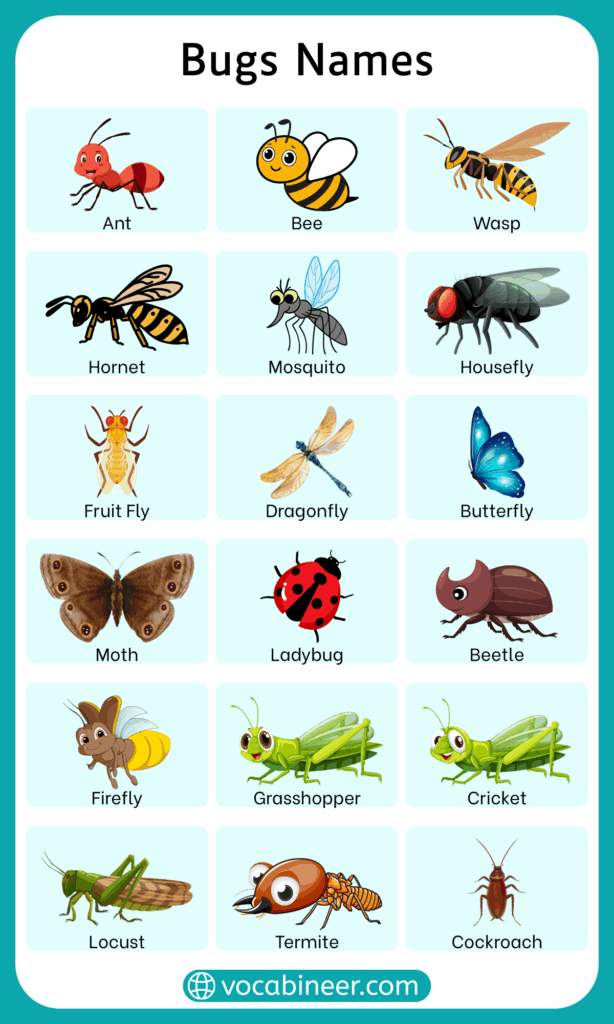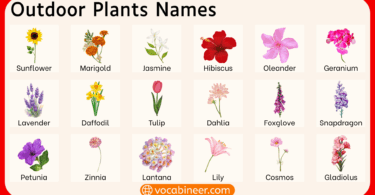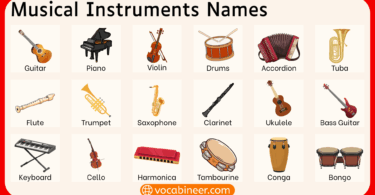Bugs names brings together insects often noticed indoors, outdoors, or around plants. Each name identifies a unique small creature that belongs to the wider insect family. By learning these insect names in English, readers gain clarity in classrooms and biology lessons. The list of 80 bugs names in English with their pictures also supports everyday talks about bugs in a natural way.
In This Page
List of Common Bug Names in English
Common bugs are often seen in daily life, from outdoors to indoors. They come in many forms, with different body shapes and habits.
- Mosquito: Small flying insect with slender body that bites humans and animals to suck blood, often found near water.
- Housefly: Grayish-black flying insect with large red eyes, known for buzzing indoors and carrying germs on its feet.
- Fruit fly: Tiny insect attracted to ripe or rotting fruit, often swarming around kitchens and garbage bins in homes.
- Moth: Soft-bodied insect with feathery antennae, usually active at night, sometimes damaging stored clothes and pantry goods.
- Dragonfly: Long-bodied insect with large transparent wings, quick flier often near ponds and rivers, known for hunting mosquitoes.
- Gnat: Very small flying insect that sometimes bites, often forming clouds in damp areas or around plants in summer.
- Ant: Small crawling insect living in colonies, builds nests underground, and works together to carry food many times its size.
- Cockroach: Flat-bodied insect with long antennae, often hides in kitchens and bathrooms, known for surviving in difficult conditions.
- Termite: Pale, soft-bodied insect living in large groups, famous for eating wood and damaging wooden furniture or buildings.
- Beetle: Hard-shelled insect with wing covers, many species exist, some eat plants while others feed on stored grains.
- Earwig: Dark brown insect with pincers at its rear end, crawls into small spaces, sometimes found under garden pots.
- Flea: Tiny jumping insect that lives on animals, bites skin to feed on blood, and can spread very quickly indoors.
- Tick: Small arachnid that attaches to skin of animals or humans, feeds on blood, and sometimes spreads diseases.
- Wasp: Slim-bodied insect with narrow waist and painful sting, builds papery nests, sometimes aggressive when disturbed.
- Hornet: Large type of wasp with strong sting, usually builds nests in trees, feared for its painful attack.
- Butterfly: Colorful winged insect with slender body, active during the day, often seen flying around flowers in bright sunlight.
- Cricket: Brown or green insect with long antennae, makes a chirping sound at night by rubbing its wings together.
- Grasshopper: Jumping insect with strong legs, often feeds on grass and crops, makes soft clicking sounds while moving.

Names of Household Bugs Found Inside the Home
Household bugs are insects that people often notice inside homes. Some damage furniture or clothes, while others are simply a nuisance.
- Bed bug: Small reddish-brown insect that hides in mattresses and bites humans at night, leaving itchy red marks on skin.
- Silverfish: Tiny wingless insect with silvery scales, quick-moving and often found in bathrooms or paper-filled shelves.
- Carpet beetle: Small beetle with patterned back, larvae feed on fabrics, carpets, and stored clothing inside cupboards.
- Flea: Jumping insect that bites pets and humans indoors, usually found in bedding, carpets, or near animals.
- Clothes moth: Small moth whose larvae chew holes in wool, fur, and fabric, often hidden in dark storage areas.
- Pantry moth: Small moth that infests flour, grains, or cereals in kitchen cupboards, leaving webs inside food packages.
- Spider beetle: Tiny beetle with round body, sometimes mistaken for spider, usually feeds on dried food products.
- Booklice: Minute insect found in damp books and paper, feeds on mold and fungi, harmless but annoying inside homes.
- Centipede: Long-bodied arthropod with many legs, moves quickly across floors, usually hunts other small insects in houses.
- Dust mite: Microscopic creature living in bedding, carpets, and sofas, feeds on skin flakes, known to cause allergies.
Garden Bugs That Live Among Your Plants
Garden bugs play different roles in plants and soil. Some protect plants by eating pests, while others may harm leaves or stems.
- Ladybug: Round beetle with spotted back, considered beneficial because it eats aphids and helps protect garden plants.
- Stink bug: Shield-shaped insect with green or brown body, releases unpleasant smell when disturbed or crushed.
- Aphid: Tiny soft-bodied insect that sucks sap from plants, often gathers in large groups on leaves and stems.
- Grasshopper: Strong-legged insect that jumps long distances, feeds on green plants and sometimes damages garden crops.
- Leafhopper: Small wedge-shaped insect that jumps quickly, feeds on plant sap, and sometimes spreads plant diseases.
- Praying mantis: Green or brown insect with folded front legs, hunts and eats other insects, useful in controlling pests.
- Caterpillar: Soft-bodied larva of butterflies or moths, chews leaves, sometimes causes damage to crops and plants.
- Whitefly: Tiny white insect with powdery wings, sucks sap from plants and weakens leaves by causing them to curl.
- Thrips: Very small slender insects with fringed wings, scrape and suck plant tissues, often leaving silvery patches on leaves.
- Spider mite: Tiny arachnid that spins fine webbing on plants, causes yellow spots on leaves, harmful in greenhouses.
- Cutworm: Fat caterpillar that hides in soil, cuts down young seedlings at ground level, damaging gardens and fields.
- Mealybug: Small insect covered with white cottony wax, feeds on plant sap, usually clusters on stems and leaf joints.
- Cabbage worm: Green caterpillar that eats cabbage and related plants, blends with leaves, damaging crops if not controlled.
Little Bugs That Are Easy to Miss
Some bugs are so tiny that people often overlook them. They may live indoors or outdoors but are still important in nature.
- Springtail: Very small insect-like creature that jumps on soil, often found in damp gardens or near decaying leaves.
- Booklice: Minute insect found in old books and paper, feeds on mold, harmless but annoying in damp homes.
- Dust mite: Microscopic creature living in carpets and bedding, invisible to the eye but known to cause allergies.
- Spider mite: Tiny pest that makes fine webbing on leaves, often damages plants in gardens and greenhouses.
- Gnat: Small flying insect that appears in swarms, often noticed near plants, ponds, or inside damp houses.
- Tiny ant: Very small species of ants, sometimes called sugar ants, often enter kitchens to look for food.
Flying Bugs Indoors & Outdoors
Flying bugs are among the most noticeable insects, often moving quickly through the air and landing on food, plants, or people.
- Mosquito: Slender insect that bites humans and animals, often buzzing around ears and leaving itchy marks.
- Housefly: Buzzing insect with large eyes, carries germs, and lands on food or surfaces inside homes.
- Butterfly: Brightly colored insect with patterned wings, seen fluttering around flowers in gardens and fields.
- Moth: Night-flying insect with scaly wings, some species feed on nectar while others damage clothes.
- Dragonfly: Large-winged insect flying near water, swift hunter that catches other small flying insects in midair.
- Wasp: Flying insect with yellow and black stripes, feared for its sting, often builds papery nests.
- Hornet: Bigger relative of wasps, aggressive defender of its nest, has a more painful sting than a bee.
- Lightning bug: Also called firefly, produces light in its abdomen, glowing in summer nights to attract mates.
- Gnat: Tiny insect that forms swarms, sometimes biting people when found near water or damp soil.
Bugs With “Bug” in Their Name
Some insects include the word bug in their name. These are popular in both science and everyday language.
- Stink bug: Releases a strong odor when touched, often green or brown with a shield-shaped body.
- Bed bug: Small reddish-brown insect that hides in furniture and bites at night.
- Pill bug: Round gray bug that rolls into a ball when disturbed, also called roly poly.
- Potato bug: Refers to different insects, often the Jerusalem cricket or pill bug, depending on region.
- Lightning bug: Glowing insect seen at night, another name for firefly.
- Assassin bug: Predatory insect with long body, uses piercing mouthparts to catch other bugs.
- June bug: Brown beetle that appears in early summer, often attracted to lights at night.
- Roly poly bug: Another name for pill bug, rolls up into a ball for protection.
Scientific Names of Bugs
Scientific names are used in science to identify bugs clearly. Each species has a special Latin name that avoids confusion.
| Common Name | Scientific Name |
|---|---|
| Stink bug | Halyomorpha halys |
| Lightning bug | Photinus pyralis |
| Pill bug | Armadillidium vulgare |
| Roly poly bug | Armadillidium vulgare |
| Potato bug | Armadillidium spp. |
| Ladybug | Coccinellidae |
| Bed bug | Cimex lectularius |
| Assassin bug | Reduviidae |
| June bug | Phyllophaga spp. |
| Stick bug | Phasmatodea |
| Firefly | Lampyridae |
| Brown marmorated stink bug | Halyomorpha halys |
FAQS about Bugs Names
Many people use the word insects as another name for bugs. Scientists prefer “insects” because not every small creature we call a bug is truly one, but everyday language makes both words common.
Some insects are named with the word bug because of history and habit. For example, stink bug, bed bug, and lightning bug all carry “bug” even though not all are true scientific bugs.
People often say names like ladybug or roly-poly sound the cutest. These names are friendly, easy to say, and have become part of children’s stories, games, and even nicknames in daily conversations.
Certain bug names sound funny because of how they roll off the tongue. Names like doodlebug, stink bug, and potato bug often make kids laugh, showing how names create playful feelings.
Scientific bug names, like Halyomorpha halys for the stink bug, follow Latin rules used worldwide. Common names, such as stink bug, are easier for everyday talk but can change between regions.
Read More




